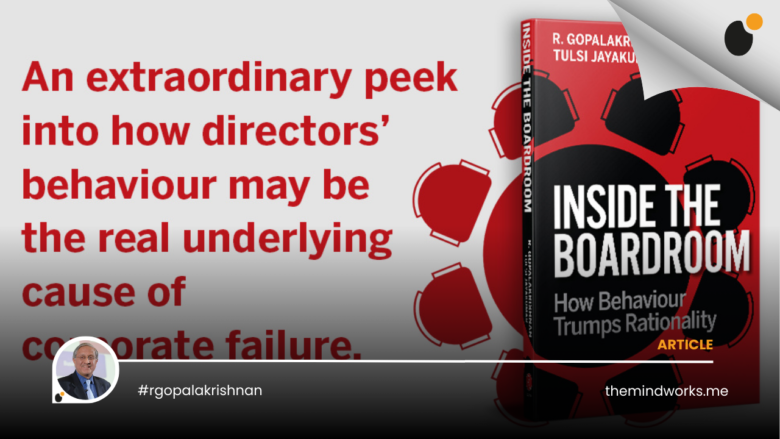Date 12th September 2023
LEADERSHIP PRODROMAL SIGNALS.
The world is facing increasing dangers from megalomaniacal leadership, arguably, more so than climate change. Individuals can respond in a limited way, but collective effort may help more. I have some thoughts on one manifestation of such leadership, that is crony capitalism. I realize that the reader may or may not agree, but just sharing thoughts.
From an enterprise perspective, the potential admixture of business and politics—crony capitalism—can be troublesome. Such entrepreneurs enjoy amazing gains during the regime of a particular political dispensation. The Economist (2nd May 2023) reports that (i) crony wealth is increasing steadily since 1998 everywhere and (ii) autocratic regimes tend to have three times more crony wealth as a percentage of GDP than democratic regimes. As autocracy spreads, so does cronyism.
Think of Hungary where Lorinc Meszaros, a former schoolmate of Victor Orban and who owned a modest pipe-fitting business, has become the richest man in Hungary with a fortune estimated by Forbes at USD 1.4 billion. Recall the case of the uber-rich Eike Batista, the charismatic oil and mining baron of Brazil, who was arrested in 2019. Think of six-year-old VinFast, a Vietnamese electric car maker, whose valuation at USD 85 billion has exceeded each of Detroit’s big three car makers. Pham Nhat Vuong, reportedly very close to those in power, owns 99 percent of VinFast, leaving very little float of his company shares. He is Vietnam’s nationalistic hero whose businesses range from noodles and real estate to cars.
Patanjali Foods (Baba Ramdev) and Adani Wilmar (Adani Group) are huge importers of palm oil among Indian importers, India itself being the world’s biggest importer of the commodity. Both companies, among India’s top packaged food producers, have a limited float of equity stocks, and have fabled market valuations.
When Swami Vivekananda travelled in America in 1890s, he felt that the world had never faced as much turmoil as it was then facing. Clearly the world has been in turmoil for long. His solution was to bathe the world in a ‘flood of spirituality’, which I would rephrase for contemporary times, as a ‘flood of humanism and compassion.’
Whether in company boards, sports bodies, gymkhanas, or nations, the consequences of dangerous leadership can be devastating. By identifying key indicators, such as a lust for power, manipulation tactics, and disregard for dissenting opinions, the chances of avoiding the calamities caused by toxic leadership can be minimized. There are archetypal attributes of dangerous leaders that have been observed for centuries. Historical leaders like Coriolanus or Julius Caesar, company leaders like Sewell Avery (Montgomery Ward) or Harold Geneen (ITT Corporation), and mythological characters like Hiranyakasipu and Ravana.
The same attributes may not manifest in every leader, nor does the presence of some attributes automatically imply danger. However, when multiple signals converge, vigilance becomes necessary. There are certain overlapping archetypes.
Narcissistic Personality: A grandiose sense of self-importance, an insatiable need for admiration, and a lack of empathy are common traits of narcissistic leaders. They view themselves as invulnerable, making them resistant to criticism and blind to their own flaws, often leading to decisions that prioritize personal gain over the well-being of their constituents.
Manipulative Communication: Leaders who skilfully manipulate their followers may exhibit rhetoric that stokes fear, division, and prejudice. By capitalizing on insecurities and exploiting societal fault lines, these leaders can easily gain support and create an “us versus them” narrative, compromising the social fabric and fostering an environment of distrust.
Power Consolidation: Leaders who relentlessly seek to centralize power, weaken institutions, and limit checks and balances can pose a significant threat. Such attempts are often accompanied by diminishing freedom of expression, restricting liberties, and targeting dissidents. History has shown that power concentrated in the hands of a select few can lead to widespread abuse and oppression.
Through my professional career, I have observed and studied this subject. Most likely, I have even been a victim of the trait. In 2017, I wrote a book, CRASH: entry and exit of CEOs. Recently, I published another book, INSIDE THE BOARDROOM: how behaviour trumps rationality. Using the materials that I have read and written about, I assembled an early warning indicator that can give an alert. The members in a sports gymkhana, corporate entity or even a nation can test whether their institution is in the grip of a potentially dangerous leader by looking for ‘prodromal’ signals.
Prodromal Test:
Here is a simple test that scores one point for every ‘yes’. A score of 12 or more out of 18 indicates a red light, a score of 6-11 is a yellow light, and below 6 can be attributed to the fact that no leader is perfect. Try this test on any prominent leader whom you are familiar with.
- Deploys seemingly acceptable and outwardly democratic methods to achieve goals; avoids revolutionary methods.
- Uses established institutions to create a scare psychosis among people.
- Promptly ejects those who do not readily cooperate.
- Prefers to speak to non-questioning audiences and avoids questioning.
- Preaches unity generally, but divides internally as needed.
- Quick to form ‘we’ team and ‘them’ team among the people.
- Expresses divisive ideas and initiates ‘hoodlum’ action principally through others mandated to do this.
- Quick to make impressive future promises which may or may not be delivered.
- Promises a future in the long-term without measurable delivery of short-term performance.
- Grabs opportunities for ceremony, pomp, and grandstanding.
- Identifies ‘hate’ segments of the population.
- Harks back recreation of ‘golden age periods’ in history .
- Attributes every weakness of the times to past leaders.
- Loves public speaking and becomes a persuasive, rabble-raising demagogue.
- Gesticulates aggressively (body and face) while speaking in public.
- Morphs from ordinary dressing to stylish dressing; becomes very conscious of personal appearance and image.
- Gathers sycophants around self and forms a tight inner circle.
- Loses feelings/empathy for others with increasing conviction that what he knows is the best.



